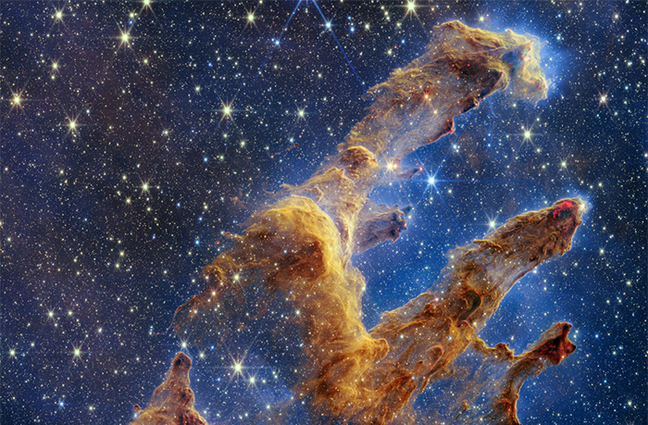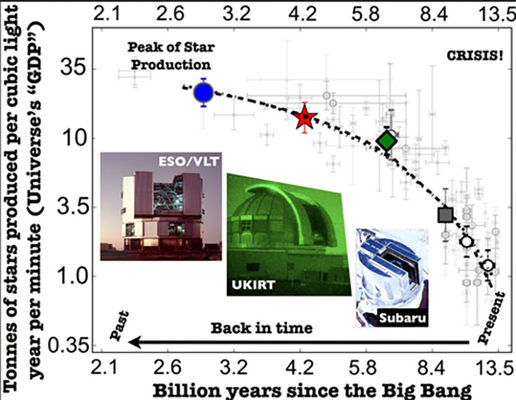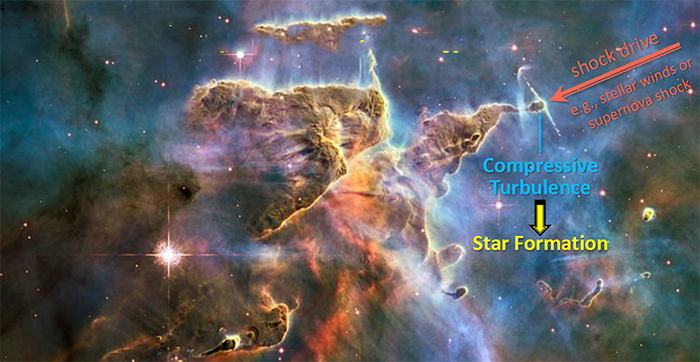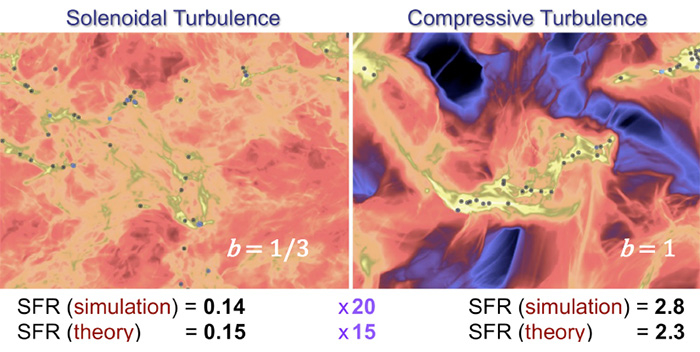Using NIF to study the sluggish pace of star formation
 (Download Image)
(Download Image)
The Pillars of Creation, a region where young stars are forming, are set off in a kaleidoscope of color in NASA’s James Webb Space Telescope’s near-infrared-light view. The pillars are filled with semi-transparent gas and dust. Credit: NASA, ESA, CSA, and STScI.
Editor’s note: The principal mission of Lawrence Livermore National Laboratory (LLNL)’s National Ignition Facility (NIF) is to support the National Nuclear Security Administration’s science-based Stockpile Stewardship Program — and with the achievement of fusion ignition in 2022 at NIF, LLNL is further exploring the possible use of nuclear fusion as a future energy source. But another important NIF mission is to enable cutting-edge science research. As a national user facility, NIF allows researchers to take advantage of the facility’s unique capabilities to conduct a wide variety of Discovery Science experiments. Here is the first in an occasional series of articles describing current NIF Discovery Science experimental campaigns:
There are roughly 100 billion stars in the Milky Way and similar galaxies, and perhaps 10 trillion galaxies in the observable universe. An estimated 2.21 sextillion (2.21x1021) stars have formed over the history of the universe.
And new stars are born all the time, in stellar nurseries like the famous “Pillars of Creation” in the Eagle Nebula, as interstellar clouds of gas are compressed to high densities by radiation-driven turbulence and ultimately by the force of gravity, triggering nuclear fusion. But scientists are having a hard time explaining why stars aren’t forming nearly as quickly as they used to — or as theory suggests they should.
“Over the past 30 years, researchers have been trying to understand why star formation is so slow,” said astrophysicist Christoph Federrath of the Australian National University in Canberra, a member of a Discovery Science team studying star formation. “Basically, some energy source or a force must exist that counteracts what would otherwise be the clouds’ fast gravitational collapse. Accounting for that inefficiency is one of the biggest challenges of modern astrophysics.”
A 2012 study found that the rate of star formation in the universe peaked around 11 billion years ago, just 2.7 billion years after the Big Bang, and has been on the decline ever since. “You might say that the universe has been suffering from a long, serious crisis,” said David Sobral of the University of Leiden in the Netherlands. “Cosmic GDP output [stars produced per cubic light year per minute] is now only 3% of what it used to be at the peak in star production.”
Sobral and his team used three different instruments — the U.K.’s Infrared Telescope, the Subaru Telescope in Hawaii and the European Southern Observatory’s Very Large Telescope in Chile — to study star-forming galaxies at different distances, and thus different epochs in the history of the universe. Their study suggested that half of all stars that have ever existed were born between 11 billion and nine billion years ago. If the measured star-formation decline continues, a maximum of just 5% more stars will be produced throughout the projected life of the universe.
There is some good news, however — our own Milky Way galaxy is outperforming most of its neighbors. A recent study using gamma-ray emission found that 10 to 20 stars are born in our galaxy every year. “We’re actually quite lucky to be living in a healthy, star-forming galaxy,” Sobral said, “which is going to be a strong contributor to the new stars that will form.”
Looking for answers
To search for solutions to the puzzle of the declining star formation rate, an international team of researchers has turned to the unprecedented capabilities of NIF, the world’s largest and highest-energy laser system. By firing its 192 high-energy lasers into a fusion target the size of a pencil eraser, NIF is able to produce temperatures of more than 100 million degrees Kelvin and pressures of hundreds of billions of earth atmospheres — sparking nuclear fusion and effectively creating a miniature “star” on Earth. In the current Discovery Science campaign, the researchers are investigating the effects of turbulence on the compressibility of gases and plasmas similar to those found in star-forming molecular hydrogen clouds.
“NIF is uniquely suited for these experiments.”
—Astrophysicist Christoph Federrath
“Simulations and theoretical models suggest a strong correlation between turbulent compression and star formation,” said LLNL design physicist Seth Davidovits, the campaign’s principal investigator. “We are adding controlled laser experiments to test the relation between the turbulent velocity dispersion and density.
“The number of laboratory experiments that are looking at these questions is pretty small,” he said. “Only NIF, with its higher energy compared to other facilities, can enable our high energy density (HED) investigations.”
“Bringing experimental HED science into mainline astrophysics and astronomy, and vice versa, will have a significant unifying impact on the reach of these two largely separate fields,” adds Federrath. “NIF is uniquely suited for these experiments, as it allows for a hydrodynamically unstable, compressible system to be created and evolved into the deeply nonlinear and turbulent regimes. It also allows the use of larger targets, which helps isolate a central portion of the experimental region from edge effects.”
A two-edged sword
Much like swirling storm clouds in the Earth’s atmosphere, interstellar molecular clouds are highly turbulent, with velocities that can be several times the speed of sound. Factors driving the turbulence include energy released by breaking and reconnecting magnetic fields, and shocks from exploding supernovas and high-intensity ultraviolet photons (stellar winds) from nearby stars.
With respect to star formation, turbulence can cut two ways: It “supports the cloud against the gravitational energy of collapse,” said David Collins of Florida State University, another member of the Discovery Science team, “but (does so) imperfectly, because the shocks also go through the cloud and create high-density regions that can collapse and decouple from the rest of the turbulence.” Those regions can then go on to form stars.
Just how turbulence plays out can depend on what’s driving it. Studies show that compressively driven turbulence yields star formation rates that are more than 10 times faster than solenoidally driven turbulence (see Physics Today, “The turbulent formation of stars”). The researchers are using NIF to study the links between turbulence driving mechanisms, turbulent density distribution and star formation.
Probing the physics
The Discovery Science campaign is studying several key physics aspects of star formation in a scaled turbulent plasma setting: the density distribution in the turbulence and its relation to the shock driving; the compressibility of the turbulence; and material transport (mixing) in the turbulence.
LLNL physicist Sabrina Nagel, group leader for the X-ray measurement and diagnostic science group, is providing experimental support for the campaign. “We’re using what’s called a shock-tube target,” in the experiments, she said. “We inject the laser beams into a gold halfraum to create a bath of radiation.”
The radiation ablates, or blows off, the surface of a plastic ablator, launching a shock into a printed foam with macroscopic manufactured voids. The turbulence generated behind the shock is controllable by the foam properties and the shock drive. A zinc backlighter produces X-rays that create a radiograph of the system before and after the shock.
“We’re using time-resolved X-ray imaging,” Nagel said, “but with radiographs, so we don’t have self-emission. Our framing camera system is the main diagnostic, with two frames per experiment to measure both the shock velocity and the distribution of line-integrated density. We’ve also used VISAR (velocity interferometry system for any reflector) to look at the timing as the shock comes out of the top and see how broken up the shock is.
“We should also highlight that we’re using two-photon polymerization (2PP) 3D-printed foam,” Nagel added. “James Oakdale and his target fabrication team here at Livermore, including William Smith and Matthew Worthington, put a great deal of effort into helping put these targets together.”
“In order to get accurate density statistics in the turbulence, we need to strongly drive a large region,” Davidovits said. “This creates a more turbulent medium while providing better statistics as well as important isolation from edge effects. (NIF’s) flexible beam configuration also provides additional experimental abilities, including launching multiple shocks from different directions — or from the same direction — and X-ray backlighting.”
Testing the models
“These star forming regions are in different conditions as you look across the universe,” Davidovits said. “We’ve analyzed the data from the first shot day and from that have inferred that conditions are similar to one particular part of the interstellar medium — the warm neutral medium in molecular clouds.
“From the first shot days we infer that the relation between the density distribution and the Mach number (velocity) of the cloud — basically, the level of the turbulence in the cloud — is very important for setting the conditions for star formation, because it determines which parts of the cloud can collapse gravitationally.”
“And we’re agreeing with some of the underlying modeling,” he added. “The goal in the upcoming shot days is to get data from the experiment in a different Mach-number regime. That will allow us to test the different theoretical relations between the amount of density variation and the level of turbulence. That’s the key thing that we’re studying.”
Joining Federrath, Davidovits, Nagel and Collins on the Discovery Science team are Nino Landen and Kumar Raman from LLNL, Saee Dhawalikar from Australian National University, Mario Manuel from General Atomics, Romain Teyssier from Princeton University, and Luz Jimenez Vela from Florida State University.
—Charlie Osolin
More Information
“Lagrangian statistics of a shock-driven turbulent dynamo in decaying turbulence,” Monthly Notices of the Royal Astronomical Society, April, 2023
“Turbulence generation by shock interaction with a highly nonuniform medium,” Physical Review E, June, 2022
“The driving mode of shock-driven turbulence,” Monthly Notices of the Royal Astronomical Society, May 30, 2022
“The turbulent formation of stars,” Physics Today, June, 2018
“Laser Experiments Illuminate the Cosmos,” Science & Technology Review, December, 2016
“NIF Users Bring Ideas and Energy to Discovery Science,” NIF & Photon Science News, October, 2016
“Unlocking the Secrets of Star Creation,” NIF & Photon Science News, April, 2015
“Dynamics of molecular clouds: observations, simulations, and NIF experiments,” SPIE Digital Library, February, 2015
Contact
 Patricia Koning
Patricia Koning
[email protected]
(925) 423-4332
Related Links
Stockpile Stewardship ProgramFusion ignition
Future energy source
Discovery Science
Pillars of Creation - Eagle Nebula
Gamma-ray emission study
Physics Today: "The turbulent formation of stars"
Laser experiments on the turbulent formation of stars
Tags
Lasers and Optical S&TPhysical and Life Sciences
Astrophysics
Lasers
Lasers and Optical Science Technology
Materials Science
Physics
Space
Featured Articles












